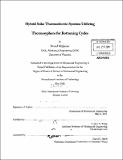Hybrid solar thermoelectric systems utilizing thermosyphons for bottoming cycles
Author(s)
Miljkovic, Nenad
DownloadFull printable version (10.76Mb)
Alternative title
HSTE systems utilizing thermosyphons for bottoming cycles
Other Contributors
Massachusetts Institute of Technology. Dept. of Mechanical Engineering.
Advisor
Evelyn N. Wang.
Terms of use
Metadata
Show full item recordAbstract
Efficient renewable energy sources are in significant demand to replace diminishing and environmentally harmful fossil fuels. The combination of commercial and residential buildings as well as the industrial sector currently consumes 72% of the total energy in the US. The abundance of solar energy promises efficient methods to meet the current heating and electricity needs. In most cases, however, current systems are limited to providing either heat or electricity only. In this thesis, we present the modeling and optimization of a new hybrid solar thermoelectric (HSTE) system which uses a thermosyphon to passively and efficiently transfer heat to a bottoming cycle for various applications including residential hot water heating, solar air conditioning, chemical drying, and aluminum smelting. The concept utilizes a parabolic trough mirror to concentrate solar energy onto a selective surface coated thermoelectric to produce electrical power. Meanwhile, the thermosyphon adjacent to the back side of the thermoelectric is used to maintain the temperature of the cold junction and carry the remaining thermal energy to a bottoming cycle. HSTEs are advantageous compared to other approaches such as hybrid photovoltaics because electrical conversion efficiencies at high temperatures can be comparable or higher to that at room temperature. The thermoelectric materials bismuth telluride, lead telluride, and silicon germanium were combined with thermosyphon material-working fluids of copper-water, stainless steel-mercury, and nickel-liquid potassium for this work. We solved the energy equation at the evaporator with a thermal resistance model of the system to determine overall performance. In addition, the HSTE system efficiency, which included the electrical efficiency of the thermoelectric and the exergetic efficiency of the bottoming cycle waste heat, was investigated for temperatures of 300 K - 1200 K, solar concentrations of 1 - 100 Suns, and different thermosyphon and thermoelectric materials with a geometry resembling an evacuated tube solar collector. Optimization was performed showing system efficiencies as high as 52.6% can be achieved at solar concentrations of 100 Suns and bottoming cycle temperatures of 776 K. In addition, thermosyphons with low wall conductivities (> 1.2 W/mK) and low solar concentrations (< 4 Suns) have comparable system efficiencies which suggests that lower cost materials, including glass, can be used. Finally, five bottoming cycle applications with temperatures ranging from 360 K - 776 K are proposed for potential HSTE integration. This work provides guidelines for the design, as well as the optimization and selection of thermoelectric and thermosyphon components for future high performance HSTE systems. Future work will focus on experimental validation and prototype building of the HSTE system.
Description
Thesis (S.M.)--Massachusetts Institute of Technology, Dept. of Mechanical Engineering, 2011. Cataloged from PDF version of thesis. Includes bibliographical references (p. 62-65).
Date issued
2011Department
Massachusetts Institute of Technology. Department of Mechanical EngineeringPublisher
Massachusetts Institute of Technology
Keywords
Mechanical Engineering.